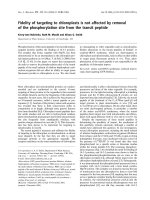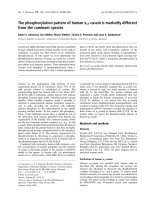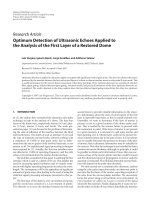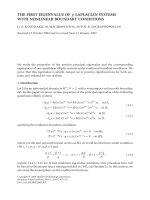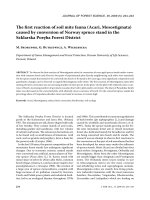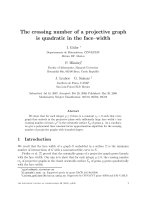The first use of cheese as food is not known
Bạn đang xem bản rút gọn của tài liệu. Xem và tải ngay bản đầy đủ của tài liệu tại đây (166.68 KB, 12 trang )
1.
History
•
•
•
The first use of cheese as food is not known.
Reference to cheese throughout history are
widespeared.” Cheese is an art that predates the
biblical era”.( Việc sử dụng đầu tiên của pho mát
làm thực phẩm là không biết đến. Tham chiếu đến
pho mát trong suốt lịch sử widespeared "Cheese là
một nghệ thuật mà trước thời đại Kinh Thánh".)
The origin of cheese has been dated to 6000- 7000
BC and worldwide number of varieties has been
estimated at 500 with an annual production of
more than 12 million tons growing at a rate of
about 4%.( Nguồn gốc của pho mát đã được ngày
6000 - 7000 trước Công nguyên và số lượng trên
toàn thế giới của các giống đã được ước tính ở mức
500 với sản lượng hàng năm hơn 12 triệu tấn, tăng
trưởng với tốc độ khoảng 4%.)
This food served as a source of vital nourishment
in huts and castles and on journeys; armies also
use cheese. It also was a way of preserving food
during periods of shortages. A plausible tracing of
the origin and development of cheese, as a food,
around the world has been published.( thực phẩm
này phục vụ như là một nguồn dinh dưỡng quan
•
•
trọng trong các túp lều và lâu đài và những cuộc
hành trình, quân đội cũng sử dụng pho mát. Nó
cũng là một cách để bảo quản thực phẩm trong thời
kỳ thiếu hụt. Một truy tìm chính đáng về nguồn gốc
và sự phát triển của pho mát, thực phẩm, trên khắp
thế giới đã được công bố.)
In 1841, Mrs. Anne Pickett made cheesemaking
history when she established Wisconsin's first
cottage industry cheese factory using milk from
neighbors' cows.
1858 - John J. Smith obtained the first cheese vat
and made cheese
Seventeen years later, John J. Smith obtained the first
cheese vat and made cheese at home in Sheboygan
County. Smith also instituted the marketing of cheese
outside Wisconsin.
•
•
Today, approximately 12,000 dairy farms, with
over 1.26 million cows producing an average of
20,630 pounds of milk each per year, continue the
reputation for quality milk from Wisconsin.
Cheesemakers use approximately 90 percent of this
milk to produce cheese at 129 plants.
NY in 1851 and was started by Jesse Williams who
began the mass production due to demand for his
•
desirable cheese.From this beginning the cheese
industry began to flourish
In 2003, the top three world cheese
producers were: 1.European Union with
5.5 million metric tons, 2.The United
States with 4.0 million metric tons, and
3.Brazil with 500,000 million metric
tons. The European Union and
theU.S. were also the leading consumers
of cheese and its related products.
•
He process has had many developments
throughout history. Nowadays, instead of
using the enzyme, rennin, a
syntheticchymotrypsin derivative is
sometimes used, along with extracts
from molds and plants. The plethora of
flavors is due to the manipulation of a
variety of factors
including:
1. The kind of milk used = cow, sheep,
goat, buffalo, reindeer, camel, yak,
etc.
2. The curding, cutting, cooking, and
forming methods.
3. The type of bacteria or mold used in
ripening.
4. The amount of salt/other seasonings
added.
2.
5. The ripening and curing conditions
= temperature, humidity, time, etc.
With over 2000 types, cheese is one of the
most versatile foods in the world.
• Currently, about one third of the milk
produced in the U.S. each year is used in
the manufacturing of cheese. Since it
does come from milk, cheese contains a
concentrated amount of almost all of the
valuable nutrients found in milk. (Hiện
nay, khoảng 1/3 của sữa sản xuất tại Mỹ mỗi năm
được sử dụng trong sản xuất pho mát. Vì nó đến từ
sữa, pho mát có chứa một lượng tập trung của hầu
hết các chất dinh dưỡng có giá trị tìm thấy trong
sữa)
Introduction
There are hundreds of different types of cheese, but
each is made using similar principles of
coagulating the proteins in milk to form curds, and
then separating the curds from the liquid whey. The
coagulation of milk proteins can be done as
follows:( Có hàng trăm các loại pho mát khác
nhau, nhưng từng được thực hiện bằng cách sử
dụng nguyên tắc tương tự của đông tụ protein trong
sữa để tạo thành sữa đông, và sau đó tách sữa đông
từ whey lỏng. Làm đông tụ protein sữa có thể được
thực hiện như sau)
Using rennet (or ‘chymosin’) - an enzyme extracted
from calves’ stomachs that coagulates the proteins in
milk. Rennet produced by micro-organisms is available
for vegetarian cheeses.
• Fermenting to form lactic acid.
• Adding acid (e.g. lemon juice, lime juice or vinegar).
• Boiling or
• Using plant extracts (e.g. papaya sap (papain enzyme),
fig bark (ficin enzyme), stems of Bryophylum species or
leaves of Calotropis procera.( Sử dụng men dịch vị
(hoặc 'chymosin) - một loại enzyme chiết xuất từ dạ dày
bê coagulates các protein trong sữa. Rennet được sản
xuất bởi các vi sinh vật có sẵn cho phó mát chay.
• lên men để tạo thành axit lactic.
• Thêm acid (ví dụ như nước chanh, nước chanh hoặc
dấm).
• Đun sôi hoặc
• Sử dụng các chất chiết xuất từ thực vật (ví dụ như đu
đủ sap (papain enzyme), vỏ cây vả (ficin enzyme), bắt
nguồn của các loài Bryophylum hoặc lá Calotropis
procera.)
Hard cheeses (e.g. ‘Cheddar’ cheese) and largecurd cottage cheese are produced using lactic acid
bacteria and rennet. (pho mát cứng (ví dụ như
'Cheddar' pho mát) và pho mát cottage sữa đông
lớn được sản xuất bằng cách sử dụng vi khuẩn axit
lactic và men dịch.)Hard cheese requires greater
investment in equipment and greater skill to
produce than soft cheeses.
Hard cheeses may also be made with a variety of
flavourings, including caraway seed, chilli pepper,
garlic, rosemary or sage, or they may be smoked.(
Pho mát cứng cũng có thể được thực hiện với nhiều
hương liệu, bao gồm cả hạt giống cây ca-rum, hạt
tiêu ớt, tỏi, lá hương thảo hoặc cây xô thơm, hoặc
họ có thể được hút thuốc.) It is recommended that
market research be undertaken to find which types
of cheese are popular before contemplating
production, because the demand for hard cheeses
may be more limited in some countries and a
careful market analysis is needed before starting
their production.
Training in production should then be obtained
from an experienced cheese-maker.
Cheese is preserved by a number of different
mechanisms: the raw milk is pasteurised to destroy
most enzymes and contaminating bacteria;
fermentation by lactic acid bacteria increases the
acidity which inhibits growth of food poisoning
and spoilage bacteria; the moisture content is
reduced and salt is added, both of which inhibit
bacterial contamination (Cheese được bảo quản
bằng một số cơ chế khác nhau: sữa tươi tiệt trùng
để tiêu diệt hầu hết các enzyme và vi khuẩn ô
nhiễm, quá trình lên men bởi các vi khuẩn axit
lactic làm tăng nồng độ axit trong đó ức chế sự
tăng trưởng của ngộ độc thực phẩm và vi khuẩn hư
hỏng, độ ẩm giảm và muối làthêm vào, cả hai đều
ức chế nhiễm
khuẩn).
There are three kind of cheese: soft cheese, semihard cheese, hard cheese
Table 1: Types of cheeses (Adapted from Dairy Science and
Technology Education)
.
Typ
e of
Che
ese
Moist
ure
conte
nt
(%)
(độ
ẩm)
Soft
45-75
cheese
s
Semi- 35-45
hard
Chees
es
Hard
30-40
Fat
Texture( Shelf
conte cấu tạo) life( th
nt
ời hạn
(%)
sử
( hàm
dụng)
lượng
chất
béo)
<40
Soft, white, A few
spreadable days
<35
<30
Firm,
crumbly,
can be
sliced
Very firm,
A few
months
One
Chees
es
3.
dense,
year or
sometimes more
grainy
Production process
1. Standardize Milk
Milk is often standardized before cheese making to optimize the protein to fat ratio
to make a good quality cheese with a high yield
2. Pasteurize/Heat Treat Milk
Depending on the desired cheese, the milk may be pasteurized or mildly heattreated to reduce the number of spoilage organisms and improve the environment
for the starter cultures to grow. Some varieties of milk are made from raw milk so
they are not pasteurized or heat-treated. Raw milk cheeses must be aged for at least
60 days to reduce the possibility of exposure to disease causing microorganisms
(pathogens) that may be present in the milk.
3. Cool Milk
Milk is cooled after pasteurization or heat treatment to 90°F (32°C) to bring it to
the temperature needed for the starter bacteria to grow. If raw milk is used the milk
must be heated to 90°F (32°C).
4. Inoculate with Starter & Non-Starter Bacteria and Ripen
The starter cultures and any non-starter adjunct bacteria are added to the milk and
held at 90°F (32°C) for 30 minutes to ripen. The ripening step allows the bacteria
to grow and begin fermentation, which lowers the pH and develops the flavor of
the cheese.
5. Add Rennet and Form Curd
The rennet is the enzyme that acts on the milk proteins to form the curd. After the
rennet is added, the curd is not disturbed for approximately 30 minutes so a firm
coagulum forms.
6. Cut Curd and Heat
The curd is allowed to ferment until it reaches pH 6.4. The curd is then cut with
cheese knives into small pieces and heated to 100°F (38°C). The heating step helps
to separate the whey from the curd.
7. Drain whey
The whey is drained from the vat and the curd forms a mat.
8. Texture curd
The curd mats are cut into sections and piled on top of each other and flipped
periodically. This step is called cheddaring. Cheddaring helps to expel more whey,
allows the fermentation to continue until a pH of 5.1 to 5.5 is reached, and allows
the mats to "knit" together and form a tighter matted structure. The curd mats are
then milled (cut) into smaller pieces.
9. Dry Salt or Brine
For cheddar cheese, the smaller, milled curd pieces are put back in the vat and
salted by sprinkling dry salt on the curd and mixing in the salt. In some cheese
varieties, such as mozzarella, the curd is formed into loaves and then the loaves are
placed in a brine (salt water solution).
10. Form Cheese into Blocks
The salted curd pieces are placed in cheese hoops and pressed into blocks to form
the cheese.
11. Store and Age
The cheese is stored in coolers until the desired age is reached. Depending on the
variety, cheese can be aged from several months to several years.
12. Package
Cheese may be cut and packaged into blocks or it may be waxed.
4.
Benefit
Everybody knows dairy products are an essential part of a healthy,
balanced diet, and although preventing osteoporosis is often the first
thing people think of when they consider the health benefits of
consuming dairy products, there is a growing list of ways that dairy can
improve your health.
•
Research has shown that increased consumption of dairy products,
by both children and adults, results inincreased bone density later in
life and a reduced risk of osteoporosis.
•
Numerous studies have found that increasing the intake of calcium,
potassium and magnesium – nutrients found in dairy foods – lowers
blood pressure and helps reduce the risk of hypertension.
•
Several studies link the intake of dairy foods with decreased risk
of certain cancers, such as colon and breast cancer.
•
Certain cheeses, such as Cheddar, Swiss, Blue, Monterey Jack and
processed American cheese, among others, have been demonstrated
to reduce the risk of dental cavities.
/>


